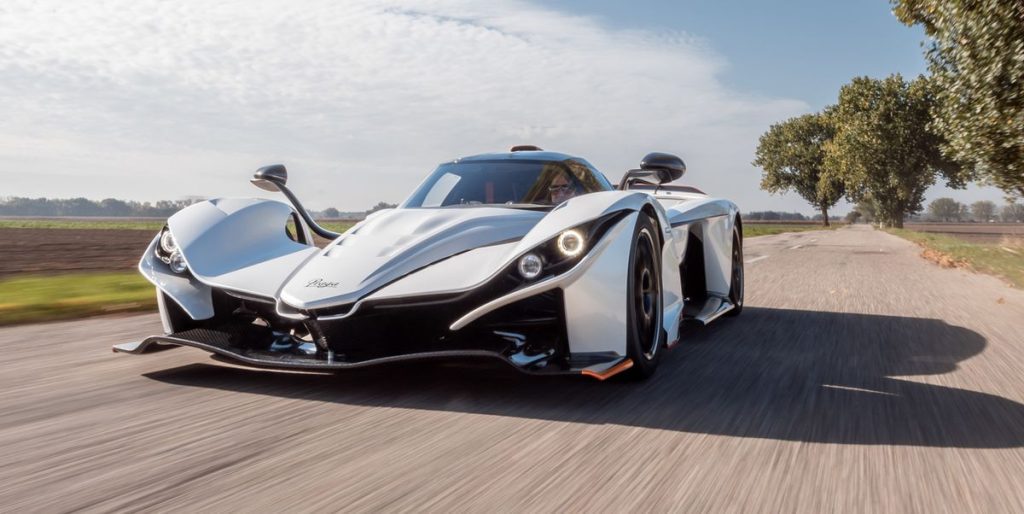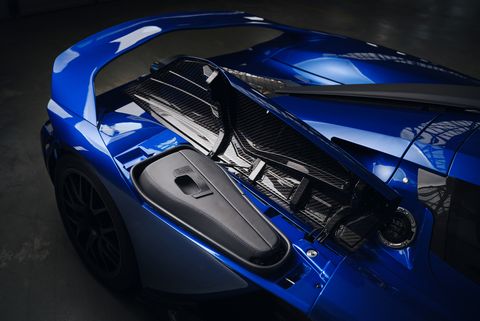Praga Bohema, Czech Hypercar, Blurs the Line between Road Car and Race Car

Praga is a Czech automaker on the verge of launching a spectacular hypercar with a power-to-weight ratio that makes the McLaren Senna look obese. We’ve now driven that car, the Bohema, in prototype form on a circuit in the U.K.
Although its name might not be familiar, Praga has a long history. Before the Second World War, this Czechoslovakian company hand-built modest numbers of elegant and expensive automobiles and motorcycles. At the end of the war, now on the communist side of the Iron Curtain, there was no need or demand for such automotive decadence, and so Praga became a manufacturer of military vehicles and armaments. After communism fell, the company diversified into making trucks, aircraft, racing carts, and actual race cars—with no fewer than eight of its Praga R1 sports prototype cars competing in a dedicated championship in the U.K. last year.
The motorsport experience has been incorporated into the Praga Bohema, a limited-edition model that is definitely better thought of as road legal rather than street-sensible. For proof look no further than its invigorating combination of a 2164-pound dry weight (without fuel) and a 700-hp output, this coming from a dry-sump version of the Nissan GT-R’s 3.8-liter twin-turbo V-6, the engine reworked by well-known U.K.-based tuner Litchfield. Praga is also keen for you to know that the power output is just regarded as a starting point with the strong possibility of more powerful versions to follow—potentially even including one that would make 982 horsepower, giving the car a power-to-weight ratio of a single horsepower per kilogram of mass. Power reaches the rear axle through a race-grade six-speed Hewland sequential transmission.
It looks like a race car, but the Bohema is unrelated to the existing R1, as it uses an entirely different carbon-fiber core structure. As with the Aston Martin Valkyrie, it has been designed around a teardrop-shaped cabin pushed as close to the car’s center line as possible to improve aerodynamic performance. Standing next to the car first impressions are of how much isn’t there, given the size of the spaces behind the minimal bodywork, which create channels to sculpt airflow. Praga claims that the combination of a huge underbody diffuser and the rear wing help the car make a peak 1980-plus pounds of downforce at 155 mph.
Getting into the cabin with any degree of dignity is impossible, and the Praga makes even other hypercars look spacious and practical. The doors would be better described as windows, being small glazed panels on either side of the canopy cockpit that open upward. Entry is made by ass-shuffling across the sidepod, bracing on the roof and bodywork, and then sliding down into the seat; all but the smallest pilots will likely need to remove the removable steering wheel before attempting to get in. When riding two-up, the passenger will need to carefully fold their arms so as not to impede the driver’s ability to turn the wheel.
Once in the driver’s seat, the view is mostly of a slightly incongruous leather-trimmed steering wheel that incorporates a digital dashboard and has carbon-fiber buttons on each side. The car we drove was a prototype, but beyond its tuxedo tightness, the cabin felt impressively well-finished.
Praga
Our drive took place on the Dunsfold track in Surrey, England—best known for its use by the Top Gear TV show. Running in a figure-eight layout of the sort favored by demolition-derby promoters, we were lucky to have the circuit to ourselves. But although there are tire walls and gravel traps in some of the most obviously crashable areas, it isn’t a true racetrack, and there are still plenty of obstacles it would be easy to hit at speed.
Fortunately, the Bohema proves to have an abundance of grip—both mechanical and aerodynamic—and also the sort of handling balance that brings reassurance in something so potent. The transmission shifts with a clunk at low speeds, and the Nissan V-6 brings a buzzing vibration into the cabin. But unlike Aston’s Valkyrie, which is almost painfully noisy inside even when wearing a helmet, the Bohema is not excessively loud. Visibility is good for something so low and narrow, with the view through the curved windshield pretty much like looking through the visor of a helmet.
While hugely fast, the Bohema prototype also felt reassuringly stable. As in the GT-R, the Nissan engine isn’t a big revver, meeting its redline at just 7000 rpm. But it has a breadth of midrange muscle that helps fill the gaps between the Bohema’s ratios, and that means there’s little penalty in either upshifting early or downshifting late. Top speed is gearing limited to a relatively modest 186 mph, on the basis that it would be hard to go faster on almost any racecourse.
It took the car’s Pirelli Trofeo R semi-slick tires a few corners to warm up, but from that point on, the grip and traction levels are huge. The Bohema is also tolerant of what feels like should be daringly early throttle applications, staying hooked up even as the rear end lightens to indicate grip is running short.
While the Bohema’s steering weighting is lighter than the norm for this macho part of the market, we appreciated the assistance as speeds rose to the point where the wings and diffuser started to produce significant downforce. Once this happened, it could be flung at Dunsfold’s faster corners at what seemed to be impossible speeds. Stopping was equally assured, with the combination of carbon-ceramic brakes and the car’s minimal weight allowing it to shed speed at close to painful rates.

Praga
Indeed, beyond the discomfort caused by prolonged exposure to huge lateral g-forces, the Praga Bohema feels well suited to spending its life on track. But on the road? The jury is still deliberating that one; it does seem refined for one of the fastest cars in the world—and even features luggage storage in pannier compartments next to the rear wheels—but it is hard to imagine spending long stints in the tiny cockpit without the onset of claustrophobia.
There is also the small matter of paying for one. Praga reckons that up to a quarter of its planned run of 89 Bohemas will go to the U.S., but buyers will need to find $1.31 million to realize the dream. Yet that’s less than half of what Aston is charging for the Valkyrie, so by the mad standards of this market, the price is not outrageous, even if the car certainly is.
Specifications
Specifications
2023 Praga Bohema
Vehicle Type: mid-engine, rear-wheel-drive, 2-passenger, 2-door coupe
PRICE
Base: $1,310,000
ENGINE
twin-turbocharged and intercooled DOHC 24-valve V-6, aluminum block and heads, port fuel injection
Displacement: 232 in3, 3799 cm3
Power: 700 hp @ 6800 rpm
Torque: 535 lb-ft @ 3000 rpm
TRANSMISSION
6-speed sequential automated manual
DIMENSIONS
Wheelbase: 108.9 in
Length: 177.4 in
Width: 78.9 in
Height: 41.7 in
Passenger Volume: barely
Trunk Volume: 4 ft3
Curb Weight (C/D est): 2300 lb
PERFORMANCE (C/D EST)
60 mph: 2.0 sec
100 mph: 4.9 sec
1/4-Mile: 9.6 sec
Top Speed: 186 mph
EPA FUEL ECONOMY (C/D EST)
Combined/City/Highway: 16/14/18 mpg
This content is imported from OpenWeb. You may be able to find the same content in another format, or you may be able to find more information, at their web site.



